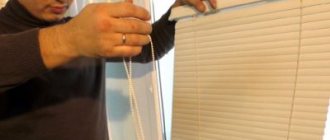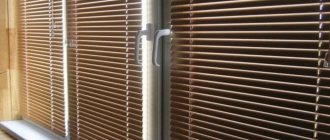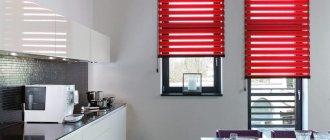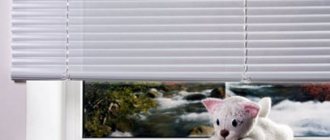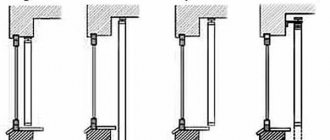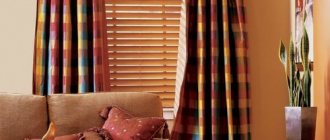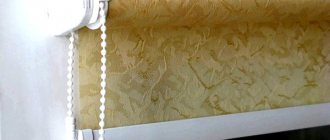Cassette blinds for plastic windows are intended only for installation separately on each fragment of a plastic window. They are divided into horizontal cassette blinds, these are blinds such as isolite and isotra, and cassette roller blinds, also represented by two systems: uni 1 (uni 1) and uni 2 (uni 2). Separate detailed articles have already been written for all these types of cassette blinds; here we will simply look at them all together and talk about their differences.
- Types of cassette blinds
- Horizontal cassette blinds
- Isolite
- Isotra
- Video
- Differences
- Photo
- Cassette roller blinds
- Uni 1
- Uni 2 (uni 2)
- Video
- Differences
- Photo
- Pleated
- With one movable cornice
- Day Night
- Video
- Differences
- Photo
- Reviews
Design Features
Cassette blinds are a canvas that can be wound into a roll. This allows you to qualitatively regulate the light flux, changing the position of the protective surface if necessary. Initially, this type of blinds was intended only for plastic windows.
The peculiarity of such models is that their installation does not require drilling the window frame. Today, cassette blinds can be installed on almost any type of window sashes.
The design consists of several main elements:
- Canvases . The shape and design can be solid or consist of several moving elements that are interconnected.
- Cassette . This concept often refers to a special shaft on which the fabric is wound. In this case, the design is equipped with a control mechanism. Many shafts are hidden in metal boxes, which allows them to be given the optimal design.
Many models have a small width, which is often equal to the size of a separate window sash.
If the windows on which you plan to install blinds have a sash with a tilting mechanism, then it is better to choose mini-cassettes. The same applies to roof windows with a slope. Mini-cassettes will allow the curtain to maintain the same angle as the window. Mini-systems have only one difference from conventional cassette blinds: the width of the lamellas (the plates from which the curtain is assembled). For mini-blinds it is used from 16 to 25 mm wide, for standard blinds - from 25 to 50 mm.
Cassette blinds are installed in such a way as to cover only the glazed surface of the window. The handles on the double-glazed windows remain accessible, and there is no need to move the curtain to perform any manipulations with the window.
Uni
The most common type of cassette roller blinds today. The peculiarity of Uni curtains is that the fabric is not simply wound on a roller, but is tightly placed in a cassette and moves along guides. This not only protects the fabric from external contamination, but also prevents the fabric from sagging if the windows are open.
There are two types: UNI 1 and UNI 2. They differ from each other in the configuration of the guides and the method of installing boxes with fabric. According to its characteristics, UNI 2 is the ideal curtain for plastic windows.
Advantages and disadvantages
When developing cassette blinds, many customer wishes were taken into account. This made it possible to create a design that will solve almost all problems in this area.
Several positive aspects of cassette blinds should be highlighted:
Practicality. Control of the system is quite simple, and the design can be adapted to almost any type of window.
Aesthetics. Manufacturers use a variety of materials when making blinds, which allows you to choose the design of the product to suit any interior style. Some modifications can be made to order.
Durability. The service life of both the material and the mechanism itself is practically unlimited. If a breakdown does occur, then all these elements can be replaced with new ones quite easily. To extend the period of operation, experts recommend properly caring for blinds.
High-quality light protection. This indicator is achieved through the use of special materials and impregnations. Some of them are able to repel dust or have a bactericidal effect.
Easy to care for. Blinds should be wiped periodically with a dry or slightly damp cloth. For metal models, additional soap solutions are used.
Ease of use. Cassette blinds fit tightly to the glass, without changing their position even with a slight tilt. In this case, a kind of air layer is formed between these surfaces, which acts as a heat-insulating layer.
Easy installation. Even an untrained person can install blinds. The main thing is to follow the manufacturer’s recommendations.
Light weight. The canvas does not create large loads on the frame, which allows you to increase its size. Therefore, such blinds can technically be made for any type of window.
It should be noted that these products are not universal and have several disadvantages:
Some types of fabric can absorb odors, which will then be impossible to remove (the rolls are not washable).
Unstable lifting mechanism. This only applies to elements that are made of plastic.
Thin lamellas are easily damaged. You can even do this by wiping them with a rag. To eliminate this feature, operation should be carried out very carefully.
Relatively complex design compared to other blinds models. This is especially noticeable when dismantling the canvas.
What types of cassette blinds are there?
Blinds with a cassette design are a fairly popular type of curtain; they differ in many parameters. This allows us to distinguish among them many models and modifications.
Roll-cassette . A feature of this design is the use of a continuous fabric sheet as a protective layer. This allows you to quickly and efficiently wind the layer into a roll, which is located inside the cassette. These models have unique properties. Conventionally, they can be divided into several subspecies:
Cassette . Standard modifications that are installed on all types of plastic windows. The width of the canvas can reach 3 m, which allows you to completely cover the entire sash. All these structures are complemented by special plumb lines that regulate the lifting of the canvas.
Mini-cassette . This type is small in size. Initially, mini-cassettes were invented for installation on non-standard windows made of wood or European construction. Today they are found in various sizes and styles.
UNI . This type of curtain is distinguished by the presence of side guides, which allow better control over the movement of the fabric. Depending on the type of these elements, several subtypes of such structures are distinguished. Often, this type of blinds is installed in offices, where they adapt well to the style of the room.
Today there are blinds consisting of several layers of fabric. Moreover, each of them is independent and has varying degrees of transparency. This allows you to lift a certain layer, thus regulating the flow of light.
Horizontal
Horizontal blinds are a canvas consisting of many thin plates (slats). All these elements are connected by a thin thread, which connects them into a single structure. It should be noted that the slats can rotate around their axis, which allows you to regulate the lighting more efficiently.
When lifted, the horizontal sheet does not roll into a roll, but is compressed. All lamellas fit tightly to each other and then hide in a decorative box (cassette). The width of the plates can vary from 16 to 50 mm depending on the material from which they are made.
A striking representative of this type are aluminum blinds, which are installed outside on doors or windows. They not only protect rooms from light, but also provide security.
Vertical
Any blinds are not just curtains, but a full-fledged mechanism consisting of many parts. At a minimum, these are: slats, connecting and control chains, runners, weights, cornice and control rope.
Lamellas are strips of fabric 89 mm wide (rarely up to 120 mm) that regulate illumination. They not only move to the right, left or to different sides from the center, depending on how many mechanisms (one or two) are installed on the cornice, but also rotate 180° around their axis.
A cornice is a device to which slats are attached. In order for the blinds to last a long time, when purchasing it, it is advisable to pay attention to the following nuances:
- Curtain rods for blinds are made of aluminum and plastic. Plastic turns yellow over time, loses its presentation and bends under the weight of curtains, so it is better to choose stronger and more durable aluminum curtain rods.
- The width of the cornice must correspond to the weight and length of the lamellas. So, for light curtains 3 m high, a cornice 2.5 m wide is sufficient, and for curtains of the same height, but heavier, a cornice at least 3 m wide is needed.
- All moving elements should move easily and smoothly. The cord and control chain must not be twisted. Otherwise, one day they will simply get stuck in the mechanism.
Runners are small parts with which the slats are held on the cornice.
Weights are weighting dies threaded into the lower parts of the lamellas. With their help, the blinds hang evenly and do not sway.
Connecting chain - a rope made of plastic or metal balls strung on a fishing line, connecting strips of fabric to each other. The control chain is made by analogy with the connecting chain. With its help, the lamellas rotate around their axis. The control rope is made of plastic. It allows you to move and extend blinds.
Material of manufacture: what to pay attention to
Blinds can be fabric or in the form of slats. The latter can be made of various materials:
- wood (mostly light species);
- bamboo;
- aluminum;
- plastic.
The principle of operation of the cassette may also differ. For fabric, it is intended to be wound into a roll, and when using lamellas, they are folded like a ladder.
Possible control methods
You can control the blinds in three ways using:
- manual control using a cord, chain or spring;
- systems with a spring mechanism;
- automatic control using a special drive.
Blinds with chain . The lamellas are adjusted by moving a specially drawn thread. This option is used very often, as it is the simplest and most reliable.
Spring . The blade is controlled using a special spring. They are very rare today, since such a design does not allow for reliable fixation.
Automatic systems . The most modern type of control. It is performed using a special electric motor, which drives the shaft or lifting thread. Control can be done either using a stationary button or from a remote control. Many systems can be equipped with light sensors that cause the mechanism to rise or fall automatically. An electronic control system equipped with an electric curtain rod will cover a larger area. To do this, there is no need to perform complex programs, simply press a button on the remote control, and using the remote control, the blinds will rise or fall automatically. The cost of electronic systems is slightly higher than that of simpler models with manual control. However, the price justifies the ease of use.
Division by material
Today the market for materials is very wide, and this practically does not limit manufacturers of blinds in using them for their needs. For horizontal cassette blinds, both natural and synthetic materials can be used.
Depending on the type of material used, blinds can be:
- made of fabric (a huge variety of materials: acrylic, viscose, cotton, linen, silk, etc.);
- made of plastic,
- made of wood,
- made of bamboo,
- made of aluminum,
- from non-woven fabric.
Several materials are used for the manufacture of horizontal structures:
Tree . The lamellas have a unique structure and also tolerate heat well. But it is not advisable to use them in a damp environment (kitchen or bathroom) as they may lose their unique design. Bamboo . One of the most popular materials. Today on the market there are both bamboo slats and unique sheets of this material that can be rolled into a roll. Aluminum . Metal tolerates external influences well. Blinds can be installed both inside and outside buildings. The slats are durable and practical. Plastic . The substance is durable and has good resistance to aggressive substances. Blinds made from it cost much less, but are not inferior in quality to other models.
As for roller blinds, they are made from a variety of fabrics, among which there are several main ones:
Acrylic . Canvases made from it are becoming increasingly rare, since the material allows air to pass through very poorly. The service life of acrylic products is relatively short, but they practically do not wrinkle. Viscose . The basis of this fabric is cellulose. These fabrics are lightweight and wash well. But the material quickly fades and loses its external characteristics. Linen . Linen fabrics have high strength and can also be used in different temperature conditions. The substance is completely natural and does not pose any danger to human health. Cotton . Natural fabric that is very easy to wash. But with constant exposure to the sun, the material gradually loses its strength. Silk . The canvases made from it are the most beautiful and expensive. At the same time, the material wrinkles and burns out very quickly. Therefore, these elements have to be frequently replaced with new products.
The curtain made from almost all materials undergoes special treatment, due to which it does not accumulate static electricity and becomes waterproof. UV impregnation significantly reduces the impact of sunlight and allows you to preserve the original color of the blinds for many years. All this simplifies their care and increases their trouble-free operation.
Expert commentary
Vladislav Dobronravov
Leading technical specialist at Okna-Media company
The variety of colors and textures of materials, as well as the use of modern printing technologies, provide enormous scope for creativity and allow you to choose the necessary model for any interior.
Blinds can be made not only in different colors, but also with drawings and photographs applied to them. Such unique blinds will make any room unusual, bright, comfortable and expressive.
Price issue
- A linear meter of cassette roller blinds will cost you from 430 rubles for a plain version and from 500 for fabric with a pattern.
- A linear meter of roller cassette blinds made of textured blackout fabric (lightproof fabric) costs about 3,500 rubles.
- You can buy Isolite horizontal cassette blinds for RUB 1,190. per product.
- Day-night blinds will cost you from 1,690 rubles. (“standard”) or 990 rub. (uni).
- Ready-made uni roller blinds can be purchased for 1,290 rubles. The “standard” option is cheaper – from 890 rubles.
- Roller blinds with electric drive can be found for 9,000 rubles. with a product size of 120 cm by 100 cm.
Use in apartment interior
Thanks to cassette blinds, you can create the effect of a different time of day in your room.
Modern technologies have made it possible to create curtains that completely block out the sun's rays. By closing the curtain with a blackout effect, you can completely stop sunlight from entering the windows, and even at the height of the day you can find yourself in a completely dark room.
These blinds are ideal in the bedroom : by hanging them on the window, you don’t have to worry that the sunlight will wake you up before you can get enough sleep.
Day-night cassette blinds can also regulate the lighting in a room. To create them, they usually use materials with different light transmittance, texture and color, or combine two curtains with different zebra-type characteristics. Thanks to such different properties, you can create the required level of illumination by simply lowering or lifting the curtain.
These blinds will fit perfectly in a room facing the sunny side. Their multi-textured fabric will absorb excess light and heat, maintaining a comfortable temperature and illumination in the room.
Blinds for balcony windows are the optimal solution. As a rule, they are aluminum, but can be made of fabric. Cassette blinds are conveniently attached and do not interfere with the opening of windows, do not interfere with movement on the balcony and are easy to clean. They can be fixed so that they cover only the glass panel, this will be very convenient and will allow you to adjust the illumination of each window individually.
Mini
The most inexpensive option. Mini curtains It is quite possible to install cassette curtains without drilling holes in the windows. Mini curtains are controlled using a closed plastic chain.
The main advantage of this design is that installation and operation of roller blinds is possible on almost all types of small window openings.
Installation methods
Installation of cassette blinds can be done in several ways:
- Adhesive . Mini structures are usually used here - reliable, lightweight and easy to operate. Installation on the sash does not require drilling; fastening is carried out using tape or special plastic or metal clamps. It is better to fasten heavy blinds with self-tapping screws. The curtain is made up to the window sill, which remains free, which is very convenient when you need to save every centimeter of space.
- On fasteners . For sliding types of window systems, adhesive fastening is not possible; the frame will not allow the sash to be opened to the side. Sometimes interior design requires covering the opening completely, for example, due to the design features of the opening or it is necessary to adjust the proportions of the space. In such cases, it is possible to install it on the wall from above or on the ceiling; fastening is done on special brackets with dowel screws.
Blinds of this type can be installed either directly on window sashes (the best way) or on the wall above or inside the opening.
To learn how to properly install blinds, watch the following video.
Scope of application of cassette curtains
For a long time it was generally accepted that this type of curtains is most suitable for office premises. In reality, this is not true at all. Thanks to a huge selection of design and execution options, they look great in any room.
Kitchen, dining room, terrace, children's room, living room, balcony, loggia, any shopping pavilion - this is not a complete list of places where you can use this element of window decor.


